|
|
本帖最後由 新漢陳Sir 於 2015-6-29 10:24 編輯
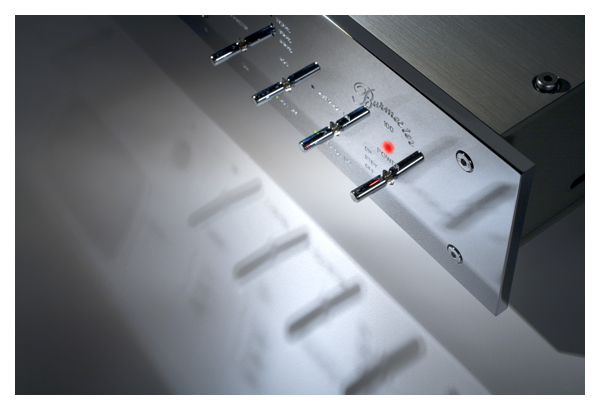
It’s been a long time since Burmester produced a phono stage. Their last model, the 838, was produced in the 80’s. However, with vinyl making such a comeback, Dieter Burmester felt the time was right to build a phono stage that was worthy of his current Reference Line components. And in typical Burmester fashion, it addresses every aspect of the analog domain – it can even be ordered with a studio quality ADC (analog to digital converter) on board, so that any vinyl enthusiast migrating to the high quality digital world has all of their bases covered.
Occupying the same amount of rack space as my reference Burmester 011 preamplifier, the sleek casework and mirror finished front panel makes for a perfect aesthetic match. When viewed under studio conditions on a bright white background, you might think the Burmester gear “too shiny,” but when it is in place in your listening room, it mirrors your environment and disappears – a pleasing aesthetic illusion.
Your final configuration determines the price: The 100 Phono outfitted with two phono preamp modules, (sans the ADC and Burmester’s Burlink interface card) has an MSRP of $22,995. The base model with one phono card and no ADC or Burlink specs out at $16,995. This probably isn’t going to be your first phono stage, but it could very well be the last one you will need to purchase – thanks both to Burmester’s legendary build quality and their commitment to product upgrades. Like other products in the Burmester range, the 100 will never become obsolete. Think of it as an investment in your vinyl future.
Ultimate flexibility
The 100 can be configured to your specification with your choice of one or two inputs. Either input can be designated as MM (moving magnet) or MC (moving coil), but once the choice has been made, the 100 must be sent back to your dealer for one of the inputs to be changed. The MM gain can be adjusted in six steps from 37 db to 52 db and the MC stage (also six steps) from 57 db to 73 db, so even the lowest output cartridges can be accommodated. Capacitance can be adjusted on the MM side from 68 pf to 400 pf and MC input loading has six options: 33, 75, 220, 390, 1000 and 47k ohms. MC purists may be put off at the odd choices, but I had no problem using cartridges that I would normally load at 100 ohms with the 75-ohm setting or the 390-ohm setting for cartridges that I would use 500 ohms on another phono preamplifier.
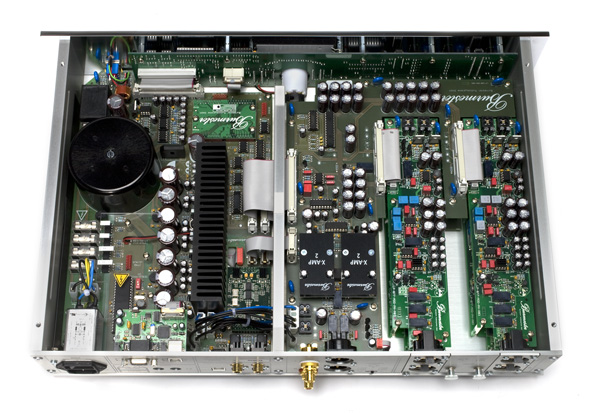
The subsonic filter worked well with a few older, more warped records that have not had a session with the Furutech flattener yet and I was unable to hear any difference in low frequency output. If the wide range of gain settings still isn’t enough, the 100 has the ability to boost the output by an additional 6db, so there should never be a situation where the 100 Phono does not possess enough gain.
Burmester’s “auto adjust” feature, when used with the supplied test record, will make up for channel imbalance in your phono cartridge. It compares the left and right channel signals, adjusting the level between channels to .2db, able to make the compensation up to 6db, though I can’t imagine a premium phono cartridge having this much channel error. The only thing missing is a mono switch.
Setup
The Model 100 sounded slightly flat out of the box compared to my other Burmester components that have been powered up for over a year now, but because there are no capacitors in the signal path, there is no long drawn out break in with this preamplifier. It opens up dramatically after a few days of constant play, and after it’s been on for about a week, you’re 100% there. If you don’t have 12 hours a day to spin records, I highly suggest a Hagerman Technologies Reverse-RIAA between your CD player and the 100. Leave it on repeat 24 hours a day for a few days to speed up the process. If you are one of the audiophiles that pooh-poohs component break in/stabilization, play your favorite record on the 100 straight out of the box and then again after a few days of burn in and you will be stunned at the improvement.
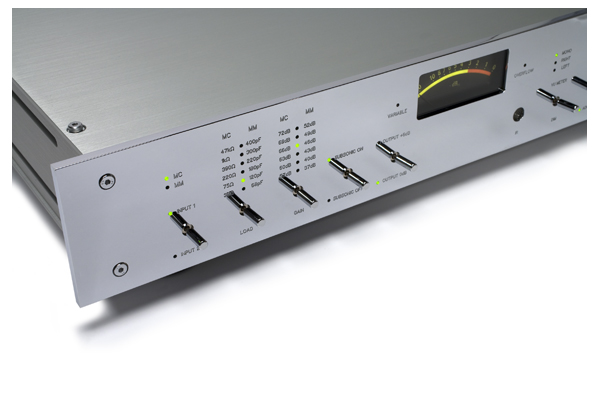
All controls are easily available on the front panel and clearly marked, so finding the proper loading and gain settings for your cartridge couldn’t be easier. If you have multiple turntable/cartridge owners will be instantly at ease with this flexibility that few other phono stages match.
For those incorporating the 100 into a non-Burmester system, there is a phase reversal switch that works with the RCA outputs as well as the balanced XLR outputs. This is particularly important because Burmester uses pin 3 for signal positive and 2 negative, while most other manufacturers do just the opposite. A quick flip of the switch keeps everything in phase.
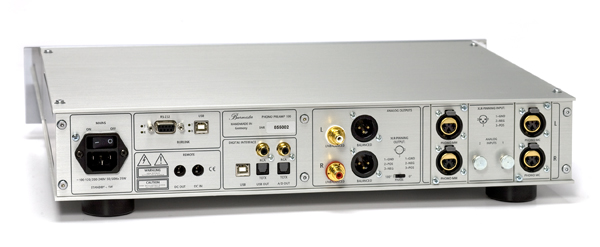
Burmester feels that keeping the signal path balanced all the way through, so the 100 only has balanced inputs. This will require cable retermination or using the supplied XLR to RCA adaptors. Considering the additional benefit to running a phono cartridge balanced, I would highly suggest having your tonearm cable terminated for balanced operation. I used a Cardas Clear Phono cable and the Burmester Silver Balanced Phono Cable ($1,595) The Burmester cable was perhaps a bit too revealing for my taste, but again like any other cable, this is a tone control that needs to be fitted to your taste.
The Sound
Having used Burmester amplification as my reference for almost two years now, I’ve become very familiar with the “Burmester sound” or perhaps lack of it. A year ago, I proclaimed the 911 mk. 3 power amplifier “The best power amplifier I’ve ever heard” and I still feel that way. Dieter Burmester has managed to design and build electronics that bridges the gap between solid-state and vacuum tubes, offering the known advantages of both with the disadvantages of neither.
Burmester electronics have always offered a tonal richness that is usually associated with vacuum tubes, yet has an equal helping of dynamic contrast and weight that normally can only be achieved with the best solid-state gear. If you are an analog lover, it’s much like the difference between hearing a master tape and a great pressing of your favorite record – the tonality has not been altered, but there is an ease, an extra level of naturalness that the record doesn’t have. If you haven’t heard the master tape you don’t know what you are missing, yet once you have, the difference is easy to discern. This is the ease in which Burmester electronics present the music.
Listening to the current Chris Bellman remaster of Van Halen II brought the first major strength of the model 100 to the front – impact. This recording now has a lot more punch, and some serious low-end energy and the model 100 was able to capture every bit of Eddie Van Halen’s guitar harmonics. It was also much easier to hear the differences between Eddie Van Halen and Michael Anthony singing harmonies on “Women In Love.” Most excellent.
Classical and ambient music lovers will appreciate the subtlety of the subsonic filter. When auditioning the vinyl edition of Brian Eno’s Small Craft on a Milk Sea, which features incredibly low synthesizer tones, I was able to play this record considerably louder than I could with the subsonic filter out – yet it never felt like there was any less bass energy on the record. Granted, this is something you probably won’t need often, but a nice feature to have available. In combination with the GamuT S9 speakers and a pair of Burmester 911 mk. 3 amplifiers, I was able to achieve sound pressure levels that you would expect to hear in a club without strain – and without a touch of acoustic feedback.
High frequencies – sublime. Again, when listening to your favorite acoustic music, the speakers just melt into the room and allow you to forget about the gear. Spinning at least half a dozen of the latest Blue Note remasters from Music Matters Jazz I was always taken back at how natural cymbals and drum heads were sounding; always with perfect attack and smooth decay. The true sign of an exceptional piece of gear, the 100 did not favor any particular type of music.
A few things always stand out with the Burmester experience beyond perfect tonality; ultra low noise, massive weight and lightning quick dynamics. The 100 stays true to the rest of my Burmester gear. Spinning the latest ORG pressing of Joni Mitchell’s The Hissing of Summer Lawns and their latest remake of Tom Petty’s Damn the Torpedoes revealed even more detail than I was used to with these two perfect pressings. This ultra quiet background always made for huge dynamic swings on records that had the scale, but also revealed a stunning amount of low-level detail as well. The 100 is one of those rare additions to your system that will offer a further look into recordings you thought you knew intimately.
This realism is further enhanced by the 100’s ability to start and stop instantly. It exhibits lightning fast response during the attack phase of a musical transient, but exhibits no overhang, stopping instantly as well. This contributes to the 100’s complete lack of fatigue when listening for long periods of time.
A few quick comparisons
To keep the playing field level, I captured some tracks at 24/192 files with my Nagra LB pro digital recorder, as I do with the other phono stages I’ve used in the last year. This offered an for an indirect comparison to the ARC REF Phono 2 and the Boulder 1008 to the 100 Phono. While this does not reveal 100% of what each of the respective phono stages can do, it’s a great way to compare phono stages past, without relying on memory alone. When comparing the high res digital samples of Hissing of Summer Lawns, it confirmed what I suspected: The Boulder offered slightly more bass grunt, and my ARC REF Phono 2 had slightly less than the Burmester. When comparing the REF to the Burmester in real time, the Burmester was definitely an order of magnitude quieter – quite possibly the quietest I’ve ever heard.
The order was reversed when listening for that image depth; here the vacuum tubes in the ARC offered a bit larger musical image with the 100 seeming to make the room a bit smaller, with the Boulder now in last place. The 100 exceeded the other two in terms of dynamic contrast and the lowest noise floor. Considering adjustability, ease of use and the thought of never having to search for vacuum tubes, makes the 100 the big winner in my book. Keep in mind that the order of magnitude we are discussing here is very small – indeed much of these differences could be minimized by cartridge choice.
When listening to Andrew Bird’s 2005 release Andrew Bird & The Mysterious Production of Eggs, I was consistently impressed by the low level detail and clarity presented. If you value a wide soundstage where images are painted in a very specific place across that sonic landscape, the Burmester is at the top of this category as well. While I haven’t had the privilege of listening to all of the top $30k – $60k phono stages yet, the Model 100 is at the top of my list in regards to everything else I’ve heard in the 10-25k range. And we still haven’t discussed the ADC…
The deciding factor in choosing the 100 over something else up in the stratosphere of phono stages will boil down to the sound you prefer and synergy with the rest of your components. Of course if you have an all Burmester system, just write the check, it doesn’t get any better or any easier.
And now for something completely digital
If you’ve been curious about high quality digital capture and are either thinking about digitizing some of your favorite LP’s for a music server or just archival purposes, the extra $2,995 spent on the ADC module is a bargain. Capturing files via USB and my MacBook Pro was fairly straightforward, (as I’ve been doing my fair share of this with other tools lately) though the instructions are fairly cryptic. Those completely new to digital capture will probably be lost, so insist that your dealer give you a good run through on this part of the process.
All digital captures taken with the 100 feature 24-bit resolution, with a choice of 48khz, 96khz or 192khz sample rates. Obviously the 24/192 files were of the highest quality, but the 29/96 files were not far behind and the 48 khz files were probably the most impressive, because they still offered excellent playback. Even using the Burmester 088 CD player as a DAC, the difference between these and the original vinyl was minimal.
Though my Nagra LB digital recorder is easier to use and more user friendly than the Burmester, the Burmester offers a significant jump in recording quality. If you have ever thought about adding this functionality to your system, the Burmester does a fantastic job. Unfortunately, you will have to transfer your files somewhere and transcode to 16/44.1, should you want to burn any of these digital files to a CD. Again, I would have liked to see this as an option in the ADC, so as to not have to perform yet another option in the digital domain.
Conclusion
If you only require one phono input and do not possess an all Burmester system, the 100 Phono is probably a bit on the high side of the price spectrum, but it becomes more reasonable (at least as reasonable as a $20,000 + phono stage can be…) as you add the second input and even more so if you make the ADC part of the bargain.
Nervous audiophiles that swap gear gear fairly often may not appreciate what makes the Burmester components such a great long-term value. They are built with the precision of a Porsche engine and placed inside casework that is fitting of the best Swiss watches. If you are someone that desires high quality audio equipment that you will live with for years to come, the Burmester 100 Phono will sound as great in 20 years as it does today. And that, on many levels is its highest value.
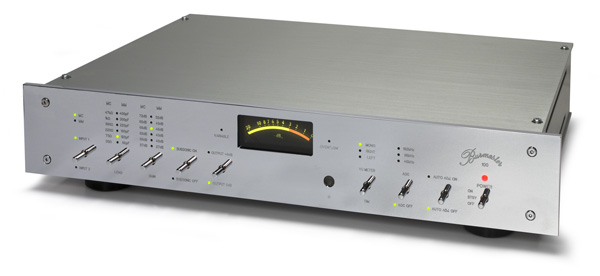
The Burmester 100 Phono
MSRP: $16,995 – $22,995 (depending on configuration)
Manufacturers Information: www.burmester.de
Peripherals
Turntables Spiral Groove SG-2 w/Triplanar, AVID Acutus Reference SP w/SME V, AVID Volvere SP w/SME 309 and Rega P9/RB1000
Cartridges Dynavector XV-1s, Koetsu Urushi Blue, Grado Statement 1, Lyra Skala, SoundSmith Sussurro Paua
Preamplifier Burmester 011, McIntosh C500
Amplifiers Burmester 911mk. 3 monoblocks, McIntosh MC 1.2kw monoblocks
Speakers GamuT S9
Review from ToneAudio by Jeff Dorgay |
評分
-
1
查看全部評分
-
|